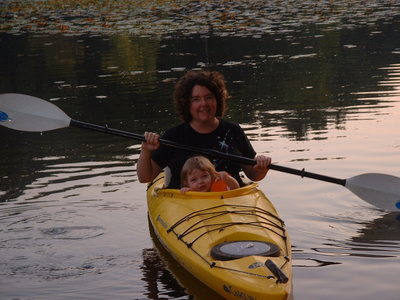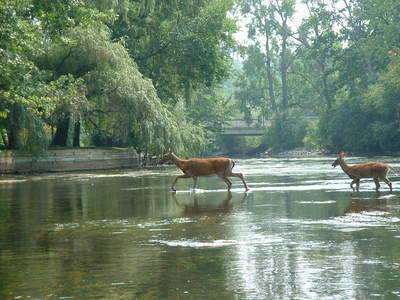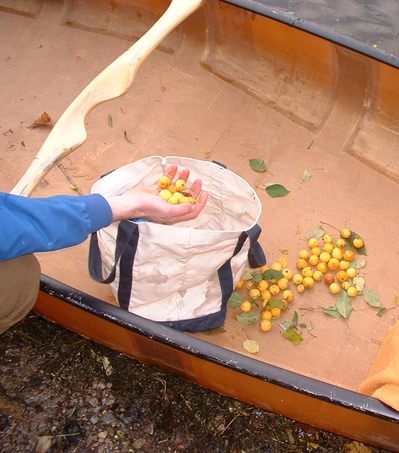Wildcrafting: 10 tips on how to find plants, and other cheap and easy resources

Laura Meisler and daughter Sylvia enjoy exploring a nearby lake by kayak.
Linda Diane Feldt | Contributor
Do you want to find wild food, new plants, herbal medicines and have adventures in nature?
You'll find 10 tips to start with, after the jump.
Ten tips to see more wild food, and other things:
1) Get out of your car.2) Get out of your house. Step outside. Spend time outside. Go out at different times during the day or night. Go out in the rain, in the snow, in the wind, in the cold, as well as when the day is perfect.
3) Look around. What do you see? If you bring your entertainment with you (cough cough iPod cough cough) you’ll be distracted from the discoveries in your path.
4) Look at your little part of the world with new eyes. It helps to change your angle - get down on the ground, or up in a tree , into the water. Use a ladder, crawl with a kid. Watch what your dog does, what they notice and smell.
5) Try a new trail and a new path - maybe get onto the water, or leave the paths entirely.
6) Keep taking the same path all year-round so you can know the same plants through the seasons.
7) Move more slowly. How fast did our ancestors go? That’s the pace we used for millions of years. That’s the pace where you’ll pick up the subtle changes and new plants, fruit and other tidbits. That’s the pace our brains were designed for when it comes to foraging.
8) Always have collection bags with you. You never know what you will find. Carry a good knife. For eating apples with bad parts, for cutting off shoots, all sorts of uses.
9) Choose transportation that creates the space for all of the above. Walking, bicycling, canoeing and kayaking are all great choices.
10) Bring your friends and family, and especially your kids (or someone else's). In many ways this learning and exploring stuff is more a kid’s world than a grownups.
How you get around is a start. Hopefully the photos and descriptions from this blog and my daily Twitter posts are helpful in knowing what to look for and when. Supplementing it with Wikipedia, Google and online plant databases will also help. I also suggest buying a number of inexpensive plant books with great photos, and a couple more books with good descriptions that may not be as good with photos. There are a few books that have both, Peterson’s "A Field Guide to Edible Wild Plants," or they also have a guide to Medicinal Plants. Both are great starting books and easy to find.

I turned a corner in a canoe and these deer were crossing the river. Not what I expected.
Linda Diane Feldt | Contributor
Some books list hundreds of plants, a paragraph for each one. Others have a whole chapter on just one or two plants. Both have their uses, collect a number of them (and support the herbalists who write them). I’m currently in love with Samuel Thayer, who wrote the Forager’s Harvest and has a new book out, "Nature’s Garden."
For a quick and easy guide, I have a PDF file on my website you can download and use to learn about a little over 30 easy to find plants in Southeast Michigan and the northeast part of the United states. The PDF file includes a brief intro to their uses. Follow this link, and click on "Spring Plants for Medicine and Food" to download the PDF file. There are no photos, but with the Latin names you can easily find a Google image for each plant online.

We found a great tasting crab apple tree while canoeing, and just added them to the bottom of the boat.
Linda Diane Feldt | Contributor
There are hundreds of wonderful nearby plants to eat, to use as medicine, and to just thoroughly enjoy. Don’t try and learn them all at once. One or two plants learned thoroughly each year is a reasonable goal. Learn a few more just by sight and name, but the ones you really learn will be especially valuable. Where it grows, how it can be used and which part, what time of year to harvest, how it spreads, if it is endangered, if it is invasive, what it looks like in all four seasons. It is even important to know if there are any look-alike plants that could be mistaken for your plant.
If you learn two new plants a year, in 10 years you’ll know 20 plants really well, and hundreds more casually. My foraging friend recommends connecting the plants you learn with events in your life. What is ripe on your birthday? Your anniversary? For example, black raspberries are ready around when kids get out of school.
You can also join me for plant walks Sept. 26 and Oct. 10. There is a small fee for these afternoon weed walks; kids 12 and younger are free. Nothing compares to in-the-field experience. I also offer free classes on herbs, focusing on the medicinal benefits. These classes are once a month, usually the fourth Thursday of the month, sponsored by The People’s Food Co-op and located at Crazy Wisdom Bookstore and Tearoom. Both websites have calendars that will give the class topic each month. Reserve your spot through the Co-op by calling 734-994-4589.
Above all, have fun. The exploration of plants and wild food will take you places and expose you to tastes and ideas you never imagined. So simple and easy.
The slideshow shows a few other outdoor scenes of foraging, including my dog Nala, a frozen Barton Dam, and my foraging friend picking without even leaving his bike.
Linda Diane Feldt is a Holistic Health Practitioner, writer and teacher with a private practice in Ann Arbor MI. You can follow her daily tweets on twitter, visit her web site, or contact her directly ldfeldt (at) holisticwisdom.org


Comments
Rork Kuick
Thu, Aug 12, 2010 : 1:16 p.m.
Mostly I'm tight-lipped, and sigh with relief lately when Linda is not talking about my favorite quarry of the month! However, I'll confess about two shrooms now, both (with study!) may be worth knowing in our area, in woods, with long periods of availability. Check on internet for associated trees and details, and cooking tips. Both are relatively easy but you must become a student of fungi, still. There are no old, bold mycophagists. 1) chanterelles (Cantharellus cibarius). A bit secret, but damn good, and incredibly expensive to purchase. There is also a small redder one (Cantharellus cinnabarinus), also good, and common, but I almost never see enough, just cause they are small. You must be able to distinguish them from a few other "look-a-likes" mentioned on almost every mushroom web page about this genus, particularly Jack o'Lantern mushroom (Omphalotus olearius, or Omphalotus illudens, and in the past, yet other scientific names). 2) Hydnum repandum (or Dentinum repandum - even the scientific names have their problems, and I know no common name around here). Some folks report this to be the equal of porcini (Boletus edulis, aka cepe, steinpilz, herrenpilz, many names) but I cannot quite agree, at least for the material around here. There is another common member of the genus around here, H. imbricatum (many names), very abundant this year, that you must be able to distinguish, but that is relatively easy - it's safety is more complicated so leave it alone. This genus is in the family Hydnaceae, and there are very few shrooms like that around here (the underside of the caps has "icicles" or "spines" - look at some pictures). Maybe they are simpler than our Morels with just a little study. There is a mushroom club in these parts offering walks that might be good for beginners near michiganmushroomhunters.org. There are many other outstanding shrooms now, and coming soon, particularly boletes, but they get trickier, so I'll just leave it alone for now. These spirits of rot can be very tasty, but it's not worth poisoning yourself, so study hard, and be cautious and conservative. Start slow. There are beautiful Amanitas of the killing kind out there now for example (Destroying Angel).
Linda Diane Feldt
Thu, Aug 12, 2010 : 10 a.m.
@trapped - PFD on board and behind the seat. Very experienced swimmer and kayaker, calm day, I'd saying wearing the vest is a judgement call, of course HAVING it on board is the law. I only wear mine in cold water, or very rough water. @Rork I would love to know more about the local mushrooms, but even with that knowledge I wouldn't teach it. It takes focused study to go safely beyond your basic morel, puffball, chicken of the woods gathering. But yes, what a year. It is hard to know what will hook people, but with plans the cheap and easy and tasty does a good job. Then we can get into environmental issues, conservation, study of how plants change, and so much more. Agreed. The feedback I've gotten says my approach is working. And I will admit to having a very open (rather than hidden) agenda in doing this. Focusing on nature creates people who care and will act to preserve it. And, being outside and foraging triggers a very deep basic happiness we've moved away from and that Twinkies can't satisfy.
Rork Kuick
Thu, Aug 12, 2010 : 8:57 a.m.
Folks interested in studying fungi do not need to be told that it has been a remarkable summer so far, cause of rain. For shrooms as well as plants and animals, I'd emphasize ecological and scientific interest more and personal gain less. However, I've done a few favors for my stomach as well, and admit such things might help motivate some people to get into biological subjects to begin with.
TrappedinMI
Tue, Aug 10, 2010 : 9:31 a.m.
Beautiful pics! (Mom, where's your life vest!)